

More Than 26 million People Have Taken a DIY Ancestry Test. As many people purchased consumer DNA tests in 2018 as in all previous years combined, MIT Technology Review has found.
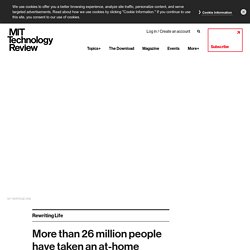
Surging public interest in ancestry and health—propelled by heavy TV and online marketing—was behind a record year for sales of the tests, which entice consumers to spit in a tube or swab their cheeks and ship the sample back to have their genomes analyzed. By the start of 2019, more than 26 million consumers had added their DNA to four leading commercial ancestry and health databases, according to our estimates. If the pace continues, the gene troves could hold data on the genetic makeup of more than 100 million people within 24 months.
The testing frenzy is creating two superpowers—Ancestry of Lehi, Utah, and 23andMe of Mountain View, California. These privately held companies now have some of the world’s largest collections of human DNA. UK Businesses Using AI to Monitor Staff. Dozens of UK business owners are using artificial intelligence to scrutinise staff behaviour minute-to-minute by harvesting data on who emails whom and when, who accesses and edits files and who meets whom and when.
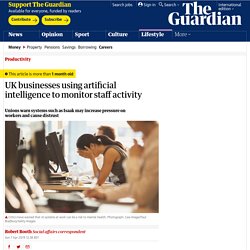
The actions of 130,000 people in the UK and abroad are being monitored in real time by the Isaak system, which ranks staff members’ attributes. Designed by a London company, Status Today, it is the latest example of a trend for using algorithms to manage people, which trade unions fear creates distrust but others predict could reduce the effects of bias. The system shows bosses how collaborative workers are and whether they are “influencers” or “change-makers”. Parents are putting GPS ankle monitors on their teenage kids. There’s no shortage of GPS trackers for parents who want to keep tabs on their children’s driving.

After all, car accidents are the leading cause of death for American teens. For some parents, that’s enough. For others, nothing but a full-on ankle monitor—the kind used to track people released on bail or parole—will do. “We offer a variety of options for parents whether they are simply looking out for their teens overall safety or concerned for the teen that may be sneaking out of the house at night or at risk of running away,” a sales video for Florida’s Tampa Bay Monitoring informs prospective customers. “Since a court order is not required, parents are increasingly turning to GPS monitoring to deter their children’s risky behavior.” Frank Kopczynski, the owner of Tampa Bay Monitoring (in fact located in Clearwater, Florida), also runs Action Plus Bail Bonds.
WIAL Deploys Skyfii to Analyse User Movements. Wellington International Airport is to deploy data collection, analytics and marketing software from Sydney-based, ASX-listed Skyfii to gather, analyse and act on data about users of the airport.
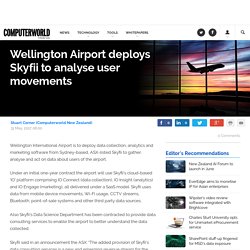
Under an initial one-year contract the airport will use Skyfii's cloud-based 'IO' platform comprising IO Connect (data collection), IO Insight (analytics) and IO Engage (marketing), all delivered under a SaaS model. Skyfii uses data from mobile device movements, Wi-Fi usage, CCTV streams, Bluetooth, point-of-sale systems and other third party data sources. Also Skyfii's Data Science Department has been contracted to provide data consulting services to enable the airport to better understand the data collected.
Skyfii said in an announcement the ASX: “The added provision of Skyfii's data consulting services is a new and emerging revenue stream for the company. This recently formed business unit is already generating strong interest from existing and potential customers.” Google Tracks Purchases & Connects Them to Online Profiles. Google’s new ability to match people’s offline credit card purchases to their online lives is a stunning display of surveillance capitalism in action.
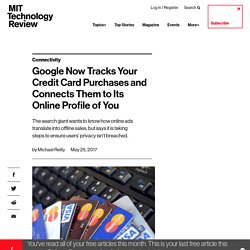
The capability, which Google unveiled this week, allows the company to connect the dots between the ads that it shows its users and what they end up actually buying. This is a crucial link for Google’s business that, for all of the company’s inventiveness, remains a matter of attracting users to its predominantly free services, collecting user data, and leveraging that data to sell advertising.
If Google can show that someone who saw an ad for a furniture store in Google Maps, say, then went and made a big purchase at that store, the store’s owner is much more likely to run more ads. Identity Fraud Hit a Record High in 2016. More than 15 million people were affected by identity fraud in the U.S. last year, according to a recent study by Javelin Strategy & Research.
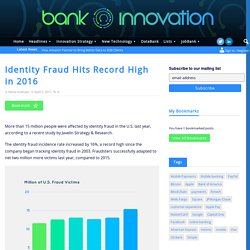
The identity fraud incidence rate increased by 16%, a record high since the company began tracking identity fraud in 2003. Fraudsters successfully adapted to net two million more victims last year, compared to 2015. The amount fraudsters took increased by nearly one billion dollars, totaling at $16 billion. “There was a resurgence in existing card fraud in 2016, which saw an increase of 40 percent in card-not-present (CNP) fraud,” the company said in a release. “The increase in EMV cards and terminals was a catalyst for driving fraudsters to shift to fraudulently opening new accounts.
More information is available here.